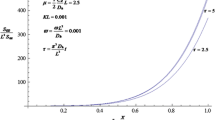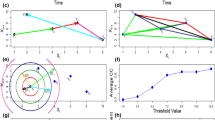Abstract
In this paper, we examined the peak flow distribution on a realization of networks obtained with stochastic network models. Three network models including the uniform model, the Scheidegger model, and the Gibbsian model were utilized to generate networks. The network efficiency in terms of drainage time is highest on the Scheidegger model, whereas it is lowest on the uniform model. The Gibbsian model covers both depending on the parameter value of β. The magnitude of the peak flow at the outlet itself is higher on the Scheidegger model compared to the uniform model. However, the results indicate that the maximum peak flows can be observed not just at the outlet but also other parts of the mainstream. The results show that the peak flow distribution on each stochastic model has a common multifractal spectrum. The minimum value of α, which is obtained in the limit of a sufficiently large q, is equal to the fractal dimension of a single river. The multifractal properties clearly show the difference among three stochastic network models and how they are related. Moreover, the results imply that the multifractal properties can be utilized to estimate the value of β for a given drainage network.








Similar content being viewed by others
References
Barndorff-Nielsen OE (1998) Stochastic methods in hydrology: rain, landforms, and floods: CIMAT, Guanajuato, Mexico, March 25–28, 1996. Advanced series on statistical science & applied probability v. 7. World Scientific, Singapore, River Edge
Block A, von Bloh W, Schellnhuber HJ (1990) Efficient box-counting determination of generalized fractal dimensions. Phys Rev A 42(4):1869–1874
Caldarelli G (2007) Scale-free networks: complex webs in nature and technology. Oxford University Press, Oxford
Cortis A, Puente CE, Sivakumar B (2009a) Nonlinear extensions of a fractal–multifractal approach for environmental modeling. Stoch Environ Res Risk Assess 23:897–906
Cortis A, Puente CE, Sivakumar B (2009b) Encoding hydrologic information via a fractal geometric approach and its extensions. Stoch Environ Res Risk Assess 24:625–632
De Bartolo SG, Gabriele S, Gaudio R (2000) Multifractal behaviour of river networks. Hydrol Earth Syst Sci 4(1):105–112
De Bartolo SG, Veltri M, Primavera L (2006) Estimated generalized dimensions of river networks. J Hydrol 322(1–4):181–191
Feder J (1988) Fractals. Physics of solids and liquids. Plenum, New York
Frisch U, Parisi G (1985) On the singularity structure of fully developed turbulence. In: Gil M, Benzi R, Parisi G (eds) Turbulence and predictability in geophysical fluid dynamics and climate dynamics. Elsevier, Amsterdam, pp 84–88
Hack JT (1957) Studies of longitudinal stream profiles in Virginia and Maryland. Shorter contributions to general geology. U.S. Government Printing Office, Washington
Halsey TC, Meakin P, Procaccia I (1986a) Scaling structure of the surface-layer of diffusion-limited aggregates. Phys Rev Lett 56(8):854–857. doi:10.1103/PhysRevLett.56.854
Halsey TC, Jensen MH, Kadanoff LP, Procaccia I, Shraiman BI (1986b) Fractal measures and their singularities: the characterization of strange sets. Phys Rev A 33:1141–1151
Ising E (1925) Beitrag zur Theorie des Ferromagnetismus. Zeitschrift für Physik A Hadrons and Nuclei 31(1):253–258. doi:10.1007/bf02980577
Karlinger MR, Troutman BM (1989) A random spatial network model based on elementary postulates. Water Resour Res 25(5):793–798
Kindermann R, Snell JL (1980) Markov random fields and their applications. Contemporary mathematics v. 1. American Mathematical Society, Providence
Leopold LB, Langbein WB (1962) The concept of entropy in landscape evolution. Theoretical papers in the hydrologic and geomorphic sciences. U.S. Government Printing Office, Washington
Meneveau C, Sreenivasan KR (1987) Simple multifractal cascade model for fully-developed turbulence. Phys Rev Lett 59(13):1424–1427. doi:10.1103/PhysRevLett.59.1424
Nagatani T (1993) Multifractality of flow distribution in the river-network model of Scheidegger. Phys Rev E 47(1):63–66
Paik K, Kumar P (2007) Inevitable self-similar topology of binary trees and their diverse hierarchical density. Eur Phys J B 60(2):247–258. doi:10.1140/epjb/e2007-00332-y
Puthenveettil BA, Ananthakrishna G, Arakeri JH (2005) The multifractal nature of plume structure in high-Rayleigh-number convection. J Fluid Mech 526:245–256. doi:10.1017/S0022112004002897
Rodríguez-Iturbe I, Rinaldo A (1997) Fractal river basins: chance and self-organization. Cambridge University Press, Cambridge
Scheidegger AE (1967a) A stochastic model for drainage patterns into an intramontane trench. Int Assoc Sci Hydrol Bull 12(1):15–20
Scheidegger AE (1967b) On topology of river nets. Water Resour Res 3(1):103–106
Seo Y, Schmidt AR (2012) The effect of rainstorm movement on urban drainage network runoff hydrographs. Hydrol Process 26(25):3830–3841. doi:10.1002/Hyp.8412
Takayasu H (1990) Fractals in the physical sciences. Nonlinear science. Manchester University Press, Manchester. Distributed exclusively in the USA and Canada by St. Martin’s Press; New York
Tarboton DG, Bras RL, Rodriguez-Iturbe I (1988) The fractal nature of river networks. Water Resour Res 24(8):1317–1322. doi:10.1029/Wr024i008p01317
Tchiguirinskaia I, Lu S, Molz FJ, Williams TM, Lavallee D (2000) Multifractal versus monofractal analysis of wetland topography. Stoch Environ Res Risk Assess 14:8–32
Tennekoon L, Boufadel MC, Nyquist JE (2005) Multifractal characterization of airborne geophysical data at the oak ridge facility. Stoch Environ Res Risk Assess 19:227–239
Troutman BM (1996) Inference for a channel network model and implications for flood scaling. In: Rundle J, Turcotte DL, Klein W (eds) Reduction and predictability of natural disasters: Santa Fe Institute Studies in the sciences of complexity proceedings, Santa Fe, New Mexico, 1994. Addision-Wesley, Reading, pp 97–116
Troutman BM, Karlinger MR (1992) Gibbs distribution on drainage networks. Water Resour Res 28(2):563–577
Williams GP (1997) Chaos theory tamed. Joseph Henry, Washington, D.C
Acknowledgments
This research was supported by a grant from Construction Technology Innovation Program (11-TI-C06) initiated by Ministry of Land, Transportation and Maritime Affairs (MLTM) of Korean government.
Author information
Authors and Affiliations
Corresponding author
Rights and permissions
About this article
Cite this article
Seo, Y., Schmidt, A.R. & Kang, B. Multifractal properties of the peak flow distribution on stochastic drainage networks. Stoch Environ Res Risk Assess 28, 1157–1165 (2014). https://doi.org/10.1007/s00477-013-0811-1
Published:
Issue Date:
DOI: https://doi.org/10.1007/s00477-013-0811-1




